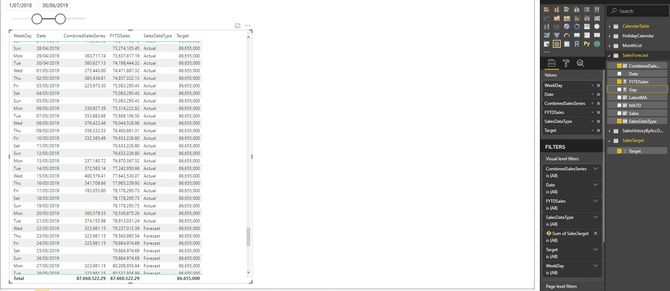- Power BI forums
- Updates
- News & Announcements
- Get Help with Power BI
- Desktop
- Service
- Report Server
- Power Query
- Mobile Apps
- Developer
- DAX Commands and Tips
- Custom Visuals Development Discussion
- Health and Life Sciences
- Power BI Spanish forums
- Translated Spanish Desktop
- Power Platform Integration - Better Together!
- Power Platform Integrations (Read-only)
- Power Platform and Dynamics 365 Integrations (Read-only)
- Training and Consulting
- Instructor Led Training
- Dashboard in a Day for Women, by Women
- Galleries
- Community Connections & How-To Videos
- COVID-19 Data Stories Gallery
- Themes Gallery
- Data Stories Gallery
- R Script Showcase
- Webinars and Video Gallery
- Quick Measures Gallery
- 2021 MSBizAppsSummit Gallery
- 2020 MSBizAppsSummit Gallery
- 2019 MSBizAppsSummit Gallery
- Events
- Ideas
- Custom Visuals Ideas
- Issues
- Issues
- Events
- Upcoming Events
- Community Blog
- Power BI Community Blog
- Custom Visuals Community Blog
- Community Support
- Community Accounts & Registration
- Using the Community
- Community Feedback
Register now to learn Fabric in free live sessions led by the best Microsoft experts. From Apr 16 to May 9, in English and Spanish.
- Power BI forums
- Forums
- Get Help with Power BI
- Desktop
- Performing a calculation involving both a measure ...
- Subscribe to RSS Feed
- Mark Topic as New
- Mark Topic as Read
- Float this Topic for Current User
- Bookmark
- Subscribe
- Printer Friendly Page
- Mark as New
- Bookmark
- Subscribe
- Mute
- Subscribe to RSS Feed
- Permalink
- Report Inappropriate Content
Performing a calculation involving both a measure and a scalar value give unexpected behaviour
Hi all,
I'm putting together what I think is a fairly simple Sales Tracking report - which tracks cummulative sales against a set target and shows what the gap is day-by-day (against both actual sales and forecasted sales).
Forecasted sales were done as a calculated column using 7-day moving averages.
And Financial Year to Date Sales (FYTDSales) was done as a measure.
Everything was working fine, as in this screenshot:
(The sales target is a number I typed and stored into a table using the "Enter Data" feature)
But as soon as I added the measure to calculate the gap into the table, each row (i.e. each "date") was then duplicated 3 times and I'm not sure why:
And as you can see, the measure definition for the gap is:
Gap =
VAR
Target=SUM(SalesTarget[Target])
Return
Target-[FYTDSales]Just in case you are wondering, I've tried rephrasing that expression multiple ways. I actually started out with
Gap = SUM(SalesTarget[Target])-[FYTDSales]
When it gave that duplicated result, I tried to restructured it, using variables and such. But it doesn't help.
Even using a physical scalar value doesn't help:
Gap = 8665500-[FYTDSales]
I really need your help. Can anyone please tell me:
1. Why is the table in the report behaving in this way?
2. What is the correct way to do this?
Help would be much appreciated.
Thank you.
Tam.
Solved! Go to Solution.
- Mark as New
- Bookmark
- Subscribe
- Mute
- Subscribe to RSS Feed
- Permalink
- Report Inappropriate Content
Ad.1 most likely there is no join between your target and actuals table (maybe due to different granularity?)
as there is no join the whole target table is evaluated for each row from sales table
Ad.2 you can either create a join between tables (which may not be possible if multiple columns would be required), or you can use TREATAS to emulate that behaviour - see article below
https://www.sqlbi.com/articles/propagate-filters-using-treatas-in-dax/
Thank you for the kudos 🙂
- Mark as New
- Bookmark
- Subscribe
- Mute
- Subscribe to RSS Feed
- Permalink
- Report Inappropriate Content
Ad.1 most likely there is no join between your target and actuals table (maybe due to different granularity?)
as there is no join the whole target table is evaluated for each row from sales table
Ad.2 you can either create a join between tables (which may not be possible if multiple columns would be required), or you can use TREATAS to emulate that behaviour - see article below
https://www.sqlbi.com/articles/propagate-filters-using-treatas-in-dax/
Thank you for the kudos 🙂
Helpful resources

Microsoft Fabric Learn Together
Covering the world! 9:00-10:30 AM Sydney, 4:00-5:30 PM CET (Paris/Berlin), 7:00-8:30 PM Mexico City

Power BI Monthly Update - April 2024
Check out the April 2024 Power BI update to learn about new features.

| User | Count |
|---|---|
| 109 | |
| 98 | |
| 77 | |
| 66 | |
| 54 |
| User | Count |
|---|---|
| 144 | |
| 104 | |
| 100 | |
| 86 | |
| 64 |


